A farm stand was selling six-packs for $3 of these pale snapdragons, bordering on chartreuse. All wonky and swaying, not ramrod straight. Never having grown snaps before, I’m unclear if a lack of basal growth is normal or just a result of the grower pushing the plants into producing a single, very tall flower. And since I’m still on a planting bender, any flower that reminds me of my mom’s lemon meringue pie just has to come home with me.
I was at the farm stand to pick up some deschampsia I had seen earlier and initially passed up. These cool-season grasses are an early presence in the garden, unlike many of the warm-season grasses I planted, just now filling out. The local plant offerings are not extensive, but I check things out frequently, assuming that there’s some hard-won local wisdom behind what they do sell.
The snapdragons are a summer fling slipped in among young, permanent plantings of phlomis, callistemon, melianthus, Choisya ‘Aztec Pearl’ — heck, unless the snaps thicken up after these blooms are done, it will be a very short summer fling of mere weeks. The orangey-gold echinaceas were picked up local too.
Another local find planted a couple months ago, Milium effusum ‘Aureum’ loves it wet and leafs out early, handling full sun fine here at the coast. I’m so glad I planted the milium, aka Bowles’ golden grass, in a pot to move around the garden to judge what doesn’t like being in proximity to shimmering chartreuse (turns out, nothing.). The Angelica stricta ‘Purpurea’ just behind is a fabulous plant up here even out of bloom, with those big winged leaves soaring out sideways and gently hovering on dark stems over the surrounding plants.
But it’s very difficult to capture its grace and the dimensionality it lends.
This hybrid, summer-blooming anemone showed up locally too, ‘Dainty Swan.’ Love the dark sepals. I had no idea the hybridizers were working on such a thing and assumed there were spring-blooming anemones and fall-blooming anemones, end of story. Fooling around with various species produced summer-blooming anemones in the ‘Swan’ series — good leaves on this one and dark stems too.
This little corner of planting with the dierama, angelica and anemone is one of my favorite views for the moment.
Bamboo hoops in the distance are for the few dahlias planted from tubers in May. I wasn’t sure I’d plant this back bed at all this year, which is where a lot of the stripped-off turf was piled for a berm effect. (The back bed is retained by two landscape timbers stacked, just visible above.) Would the decaying turf cause excessive settling? Dahlias seemed like a good temporary solution.
But of course I couldn’t resist plunging in and planting the back bed too. Sanguisorbas, patrinia, grasses, Rudbeckia maxima…I’d say the lion’s share of the plants have arrived via mail order, plus a couple trips to Portland nurseries and then the local finds.
Will the snapdragons turn out to be nothing more than two weeks’ worth of garden staging, a dozen cut flowers for $6? Possibly. And there’s nothing necessarily wrong with that either. The only downside is I’ll be constantly hungry for lemon meringue pie while they’re in bloom…

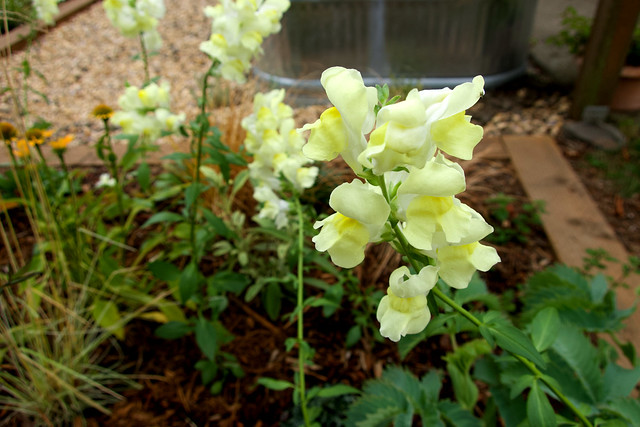
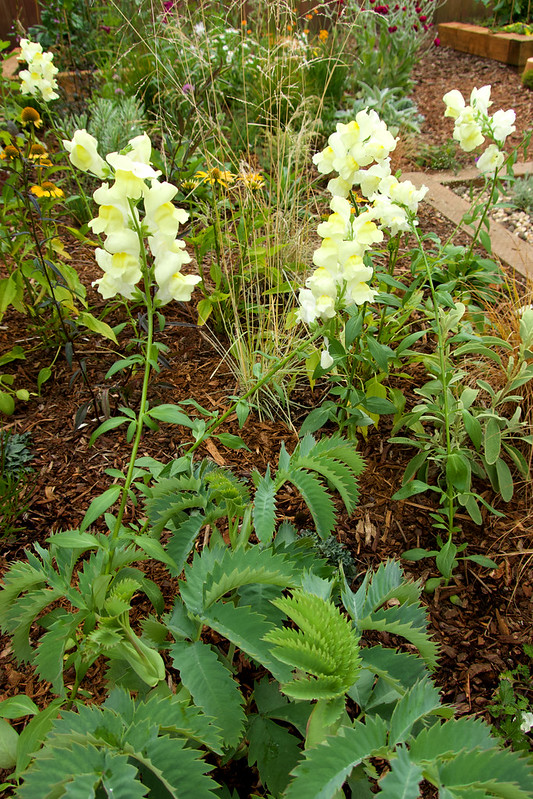
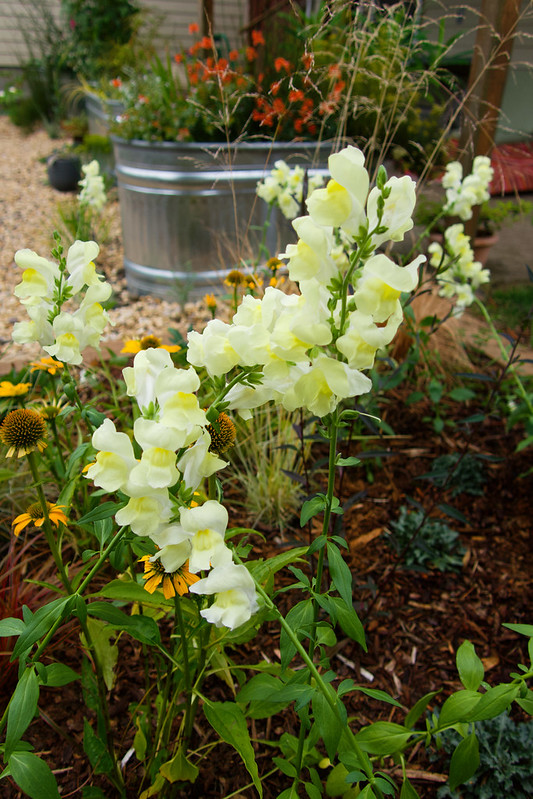
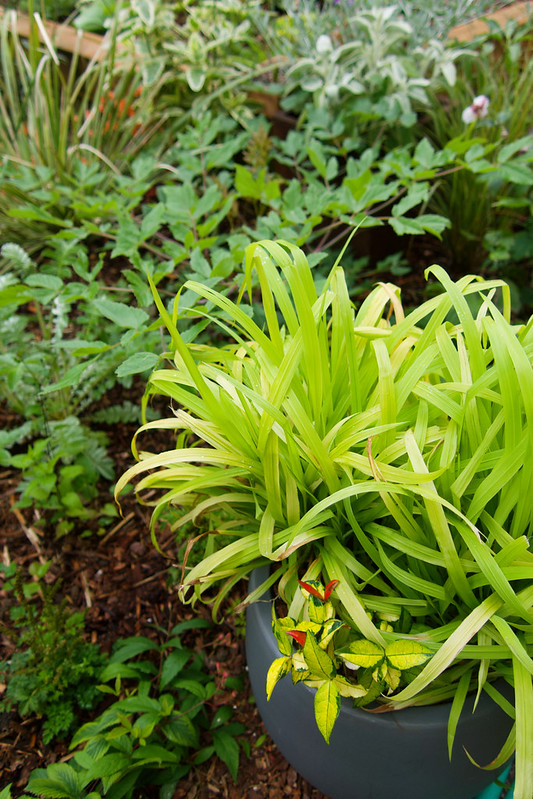


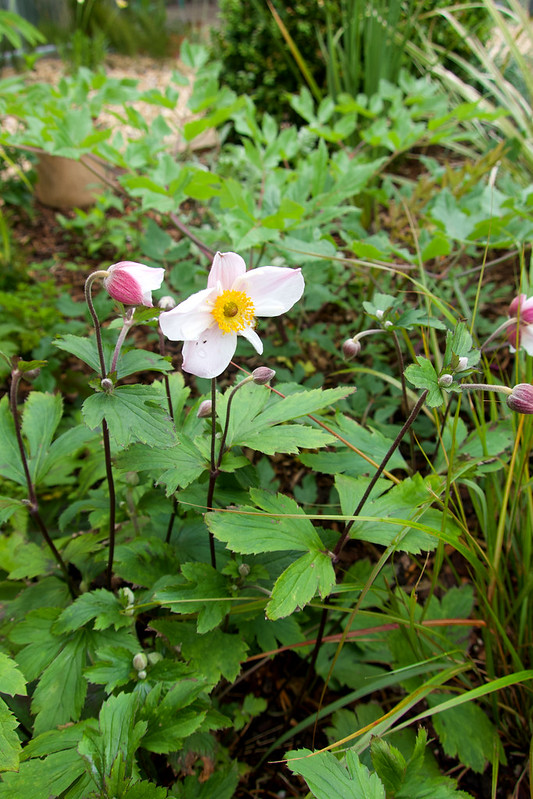
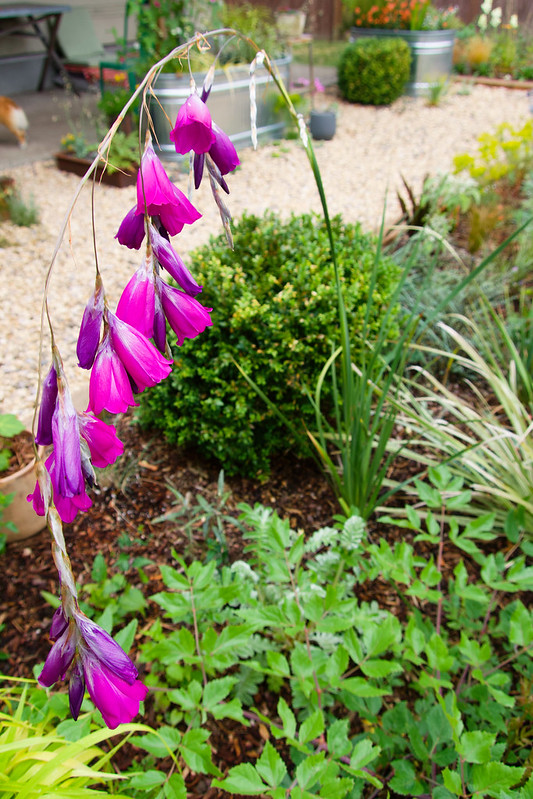




Experimentation is especially fun when you get a lot of successes! The dahlia is gorgeous. You might want to look into snapdragons in the Chantilly series. Annie’s sells the plants and Floret sells the seeds. I put in 3 small plants in December and only pulled them just this week as the flowering stems grew ever shorter.
With snaps you need to pinch out the center to cause them to branch laterally. When your bloom is finished snip it off and it will grow side branches from the remaining stem. Hopefully there will be sufficient time in the season to get more flowers. That millium is gorgeous. Am always so jealous when I see it in gardens. Too hot for it here.
@Kris, you did have quite the year with snaps! I’m thinking of adding more room for a cutting garden up here, so I might try them again if I do.
@Elaine, I’ll probably move these to the veg garden when they’re done flowering, cut off the central spike, but like you say it’s late in the season. I tried that milium before too — not a go in zone 10.
The Milium effusum ‘Aureum’ looks something like Hakonechloa macra ‘All Gold’.
Snapdragons in summer. A castor bean that won’t set seed and become a pest, a dierama that didn’t die, “late in the season” is the third week of July?
Toto, we’re not in Sunset zone 24 anymore. ;^)
Those snapdragons are wonderful! They will often perennialize (if thats a word) here in my south sound garden for several years, at least or until a really hard cold snap arrives 😉 I suspect you will find the same there. As usual, wonderful post, the garden is looking great in its first year and the dierama is to die for! Erik
Snaps are pretty easy from seeds and you get way more choices-the only place that has variety is Annies but if I’m growing for cutting it’s too pricey to buy one plant in a 4″ pot. I’m going to start seeds indoor in Sept and plant out in late Oct-they are fine with winters here. It’s recommended that you pinch off the tops when you have 4 or 6 sets of true leaves and you will have branching and still long stems for cutting.
@Hoov, it’s a whole different ballgame!
@Erik, that’s amazing that snaps perennialize for you! Thanks again for checking in.
@Kathy, I always pass up the snaps in Annies catalogue — funny how living in a town with few choices increases desirability of a plant!